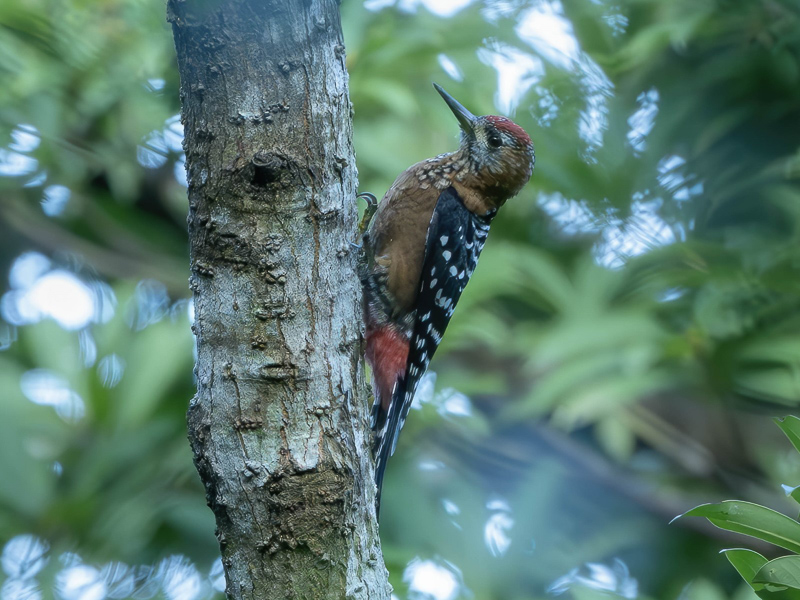Rufous-bellied Woodpecker Dendrocopos hyperythrus 棕腹啄木鳥
Category I. Accidental.
IDENTIFICATION

Oct. 2022, Claudia Leung. Male.
20-25 cm. Unmistakeable if seen well: structurally a typical medium-sized woodpecker with a black-and-white barred back and tail and plain rich buff underparts becoming rufous on the undertail coverts. Lacks the intricate head pattern of many woodpeckers; apart from the rufous crown in the male and black crown in the female, the head is otherwise rather plain and unmarked.
VOCALISATIONS
No reports of vocalisations in HK. A moderately high-pitched trilling call has been recorded elsewhere.
OCCURRENCE
1990: a first-winter male at Tai Po Kau to least 26 January 1991 (Lewthwaite 1991).
1998: one at Shing Mun on 15 February.
2022: a male at Kap Lung on 4 October.
There is some uncertainty as to the length of stay of the first individual: whilst Lewthwaite (1991) stated that it was present until 17 April 1991, Leven and Carey (1992) noted that no observations were confirmed after 26 January 1991 and these dates were followed by Carey et al. (2001).
La Touche (1931-34) described it as ‘quite unknown’ in southeast China and suggested the migration route of Rufous-bellied Woodpecker from its northeast Asian breeding area to its winter quarters has a strong southwestern orientation. Cheng (1987) considered that it did not winter east of Guangxi, whilst eBird (2022) shows no observations in eastern Guangxi, southern Hunan, Jiangxi, Fujian and Guangdong. Rufous-bellied Woodpecker seems likely to remain extremely rare in HK.
BEHAVIOUR, FORAGING & DIET
Lewthwaite (1991) stated that the bird he found foraged in typical woodpecker fashion, ‘tapping the bark, prising out (presumed) insects and invertebrates’.
RANGE & SYSTEMATICS
Rufous-bellied Woodpecker has a highly unusual distribution, strangely reminiscent of the historical distribution of Black-headed Ibis, in that the main range lies from northwest India east through the Himalayas and south through Myanmar to south Annam in Vietnam, where the three resident taxa occur. In addition, the migratory D. h. subrufinus breeds in northeast China, southeast Russia and Korea and winters in southwest China and north Indochina in the range of D. h. hyperythrus (Winkler et al. 2020).
CONSERVATION STATUS
IUCN: Least Concern. Population trend decreasing.
Carey, G. J., M. L. Chalmers, D. A. Diskin, P. R. Kennerley, P. J. Leader, M. R. Leven, R. W. Lewthwaite, D. S. Melville, M. Turnbull and L. Young (2001). The Avifauna of Hong Kong. Hong Kong Bird Watching Society, Hong Kong.
Cheng, T. H. (1987). A Synopsis of the Avifauna of China. Science Press, Beijing.
eBird. (2022). eBird: An online database of bird distribution and abundance [web application]. eBird, Cornell Lab of Ornithology, Ithaca, New York. Available: http://www.ebird.org. (Accessed: 16 July 2022).
La Touche, J. D. D. (1931-34). Handbook of the birds of Eastern China. Taylor and Francis, London.
Leven, M. R. and G. J. Carey. (1992) Systematic List. Hong Kong Bird Report 1992: 21-71.
Lewthwaite, R. W. (1991). Rufous-bellied Woodpecker in Tai Po Kau: the first record for Hong Kong. Hong Kong Bird Report 1990: 105-106.
Winkler, H., D. A. Christie, and G. M. Kirwan (2020). Rufous-bellied Woodpecker (Dendrocopos hyperythrus), version 1.0. In Birds of the World (J. del Hoyo, A. Elliott, J. Sargatal, D. A. Christie, and E. de Juana, Editors). Cornell Lab of Ornithology, Ithaca, NY, USA. https://doi.org/10.2173/bow.rubwoo1.01

